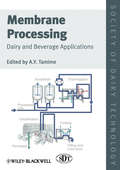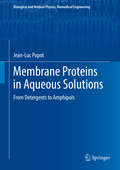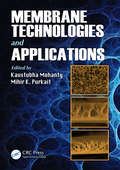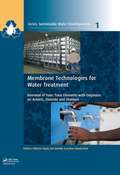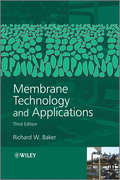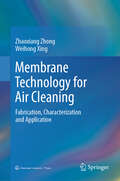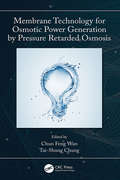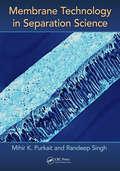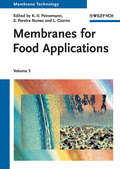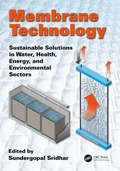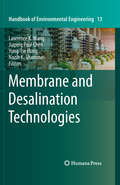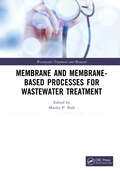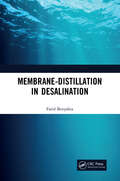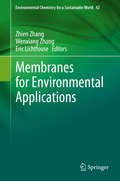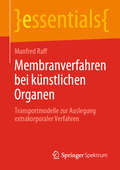- Table View
- List View
Membrane Processing: Dairy and Beverage Applications (Society of Dairy Technology)
by A. Y. TamimeIn the last two decades, there have been significant developments in membrane filtration processes for the dairy and beverage industries. The filtration systems can be classified into four main groups: reverse osmosis, nanofiltration, ultrafiltration and microfiltration. The primary objective of this book is to assess critically the pool of scientific knowledge available to the dairy and beverages industry, as a tool for process and product innovation, quality improvement and safety. The book is divided into three main parts. Part I reviews the principals, developments and designs of membrane processes that are mainly used in commercial dairy and beverage applications. Part II provides information on the applications of membrane processes in the manufacture of dairy products, from on-farm concentration of milk as a pre-treatment for cheesemaking to fractionation of milk and whey to provide ingredients for food and other applications. Part III considers membrane applications during the manufacture of fruit juices, beer and cider, wine and vinegar. These include concentration, deacidification and dealcoholisation processes. Membrane Processing: Dairy and Beverages Applications is an ideal new reference for dairy and beverage processors involved in the application of membranes, both to aid the creation of novel products, and to improve their process economics. Students and lecturers of food and dairy science and technology will value its in-depth discussion of membrane processes, whilst readers based in the dairy industry will prize it as the most up-to-date and advanced volume yet published on this crucially important topic.
Membrane Proteins in Aqueous Solutions: From Detergents to Amphipols (Biological and Medical Physics, Biomedical Engineering)
by Jean-Luc PopotThis book is the first to be entirely devoted to the challenging art of handling membrane proteins out of their natural environment, a key process in biological and pharmaceutical research, but one plagued with difficulties and pitfalls. Written by one of the foremost experts in the field, Membrane Proteins in Aqueous Solutions is accessible to any member of a membrane biology laboratory. After presenting the structure, functions, dynamics, synthesis, natural environment and lipid interactions of membrane proteins, the author discusses the principles of extracting them with detergents, the mechanisms of detergent-induced destabilization, countermeasures, and recent progress in developing detergents with weaker denaturing properties. Non-conventional alternatives to detergents, including bicelles, nanodiscs, amphipathic peptides, fluorinated surfactants and amphipols, are described, and their relative advantages and drawbacks are compared. The synthesis and solution properties of the various types of amphipols are presented, as well as the formation and properties of membrane protein/amphipol complexes and the transfer of amphipol-trapped proteins to detergents, nanodiscs, lipidic mesophases, or living cells. The final chapters of the book deal with applications: membrane protein in vitro folding and cell-free expression, solution studies, NMR, crystallography, electron microscopy, mass spectrometry, amphipol-mediated immobilization of membrane proteins, and biomedical applications. Important features of the book include introductory sections describing foundations as well as the state-of-the-art for each of the biophysical techniques discussed, and topical tables which organize a widely dispersed literature. Boxes and annexes throughout the book explain technical aspects, and twelve detailed experimental protocols, ranging from in vitro folding of membrane proteins to single-particle electron cryomicroscopy, have been contributed by and commented on by experienced users. Membrane Proteins in Aqueous Solutions offers a concise, accessible introduction to membrane protein biochemistry and biophysics, as well as comprehensive coverage of the properties and uses of conventional and non-conventional surfactants. It will be useful both in basic and applied research laboratories and as a teaching aid for students, instructors, researchers, and professionals within the field.
Membrane Reactor Engineering: Applications for a greener process industry
by Gaetano Iaquaniello Marcello De Falco Angelo Basile Gabriele CentiUniquely focussed on the engineering aspects of membrane reactors Provides tools for analysis with specific regard to sustainability Applications include water treatment, wastewater recycling, desalination, biorefineries, agro-food production Membrane reactors can bring energy saving, reduced environmental impact and lower operating costs
Membrane Reactors for Hydrogen Production Processes
by Gaetano Iaquaniello Marcello De Falco Luigi MarrelliMembrane Reactors for Hydrogen Production Processes deals with technological and economic aspects of hydrogen selective membranes application in hydrogen production chemical processes. Membrane Reactors for Hydrogen Production Processes starts with an overview of membrane integration in the chemical reaction environment, formulating the thermodynamics and kinetics of membrane reactors and assessing the performance of different process architectures. Then, the state of the art of hydrogen selective membranes, membrane manufacturing processes and the mathematical modeling of membrane reactors are discussed. A review of the most useful applications from an industrial point of view is given. These applications include: natural gas steam reforming,autothermal reforming,water gas shift reaction,decomposition of hydrogen sulphide, andalkanes dehydrogenation.The final part is dedicated to the description of a pilot plant where the novel configuration was implemented at a semi-industrial scale. Plant engineers, researchers and postgraduate students will find Membrane Reactors for Hydrogen Production Processes a comprehensive guide to the state of the art of membrane reactor technology.
Membrane Separation of Food Bioactive Ingredients (Food Bioactive Ingredients)
by Seid Mahdi Jafari Roberto Castro-MuñozThis book covers current developments in membrane-based technologies for the successful recovery of food bioactive ingredients and molecules. Chapters explore emerging technologies, such as microfiltration, ultrafiltration, nanofiltration, and membrane distillation, for the selective concentration and food ingredients from food by-products, as well as techniques, such as pervaporation, for the selective separation and recovery of aroma compounds. The text provides one of the first examinations of other membrane-based technologies, such as liquid membranes (microemulsions), membrane distillation (MD) and pervaporation (PV), as thermal driven membrane processes. The separation of metabolites from microalgae and fermentation broths using membrane technologies is also covered. Researchers in food science, pharmaceutics and biotechnology looking to stay up-to-date on bioactive recovery, as well as membranologists exploring new applications for membrane-based technologies, will find this text a useful resource.
Membrane Technologies and Applications
by Mihir K. Purkait Kaustubha MohantyCompiling recent advances in membrane separations technology, this highly relevant book introduces cost-effective solutions for separation problems in a wide range of industries. It discusses membrane use in water and wastewater treatment; food and dairy industry and fuel cell applications. It describes the role of membrane technologies in resource recovery, pollution prevention, and energy production, as well as environmental monitoring and quality control. A concise resource for emerging technologies, this book provides the tools to implement effective production processes, improve environmental protection and public health, and explore new opportunities for the industry.
Membrane Technologies for Heavy Metal Removal from Water
by Juhana Jaafar Asad A. Zaidi Muhammad Nihal NaseerThis book offers lucid treatment of fundamental concepts related to potential applications and prospects of different membranes for wastewater decontamination by removing heavy metals. Divided into four sections, it provides an overview of different sources of water contamination, their impacts on human health and the environment, and compares traditional methods used to nullify these impacts. Further, it covers different mature membrane technologies such as polymeric membranes, poly-ceramic membranes, carbon-based membranes and many more, followed by pertinent case studies.Features: Focuses on the removal of heavy metals using membrane-based technologies Discusses pertinent criteria to select suitable membranes Includes feasibility studies and applications of different mature and emerging membranes Describes heavy metals' occurrence and transport in an aqueous system with an overview of the adverse effects Reviews challenges and opportunities associated with using different membranes This book is aimed at graduate students and researchers in materials science, water engineering and wastewater treatment.
Membrane Technologies for Water Treatment: Removal of Toxic Trace Elements with Emphasis on Arsenic, Fluoride and Uranium (Sustainable Water Developments - Resources, Management, Treatment, Efficiency and Reuse #1)
by Jan Hoinkis Alberto Figoli Jochen BundschuhFocuses on the application of membrane technologies in removing toxic metals\metalloids from water. Particular attention is devoted to the removal of arsenic, uranium, and fluoride. These compounds are all existing in the earth’s crust at levels between two and five thousands micrograms per kg (parts per million) on average and these compounds can be considered highly toxic to humans, who are exposed to them primarily from air, food and water. In order to comply with the new maximum contaminant level, numerous studies have been undertaken to improve established treatments or to develop novel treatment technologies for removing toxic metals from contaminated surface and groundwater. Among the technologies available, applicable for water treatment, membrane technology has been identified as a promising technology to remove such toxic metals from water. The book describes both pressure driven (traditional processes, such as Nanofiltration, Reverse Osmosis, Ultrafiltration,etc) and more advanced membrane processes (such as forward osmosis, membrane distillation, and membrane bio-reactors) employed in the application of interest. Key aspect of this book is to provide information on both the basics of membrane technologies and on the results depending on the type of technology employed.
Membrane Technology Enhancement for Environmental Protection and Sustainable Industrial Growth (Advances in Science, Technology & Innovation)
by Mohamed Mehdi Chehimi Zhien Zhang Wenxiang ZhangThis book presents a detailed discussion of the fundamentals and practical applications of membrane technology enhancement in a range of industrial processes, energy recovery, and resource recycling. To date, most books on the applications of membrane technology have mainly focused on gas pollution removal or industrial wastewater treatment. In contrast, the enhancement of various membrane processes in the areas of energy and the environment has remained largely overlooked. This book highlights recent works and industrial products using membrane technology, while also discussing experiments and modeling studies on the membrane enhancement process.
Membrane Technology and Applications
by Richard W. Baker"... the best handbook on membrane technology, which is currently on the market... " -Membrane News (on the previous edition)Building on the success of the previous edition, Membrane Technology and Applications Third Edition provides a comprehensive overview of separation membranes, their manufacture and their applications. Beginning with a series of general chapters on membrane preparation, transport theory and concentration polarization, the book then surveys several major areas of membrane application in separate chapters. Written in a readily accessible style, each chapter covers its membrane subject thoroughly, from historical and theoretical backgrounds through to current and potential applications. Topics include reverse osmosis, ultrafiltration, pervaporation, microfiltration, gas separation and coupled and facilitated transport; chapters on electrodialysis and medical applications round out the coverage.NEW TO THE THIRD EDITIONNew sections on the use of membranes in the chlor-alkali industry, membrane distillation, pressure retarded osmosis and constant flux-variable pressure ultrafiltrationZeolite and ceramic membranes, submerged membrane modules, and fuel cell membranesSubstantially enhanced chapters on ultrafiltration, pervaporation and membrane contactorsUpdates to every chapter to reflect the developments in the field
Membrane Technology and Applications
by Richard W. BakerMembrane Technology and Applications Internationally acknowledged text on separation membrane technology, presenting current theory and practice, plus manufacturing and applications The 4th Edition of Membrane Technology and Applications presents an authoritative, up-to-date overview of separation membranes, their theoretical underpinnings, manufacture, and use, beginning with a series of general chapters on membrane preparation, transport theory, and concentration polarization, then surveying the major areas of membrane application in separate chapters. Written in a readily accessible style, each chapter offers a thorough treatment of its subject, from historical and theoretical backgrounds through to current and potential applications. Topics include reverse osmosis, ultrafiltration, microfiltration, gas separation, pervaporation, electrodialysis, coupled and facilitated transport, and medical applications of membranes. This new edition has been comprehensively updated, with substantial new material, figures, and references throughout to reflect the latest developments in the field. Major changes include: A new chapter on transport mechanisms in finely microporous membranes, with focus on gas transport A new chapter on membrane contactors A substantially expanded section on hyperfiltration applications, including pharmaceutical applications, in the reverse osmosis chapter Expanded treatment of membrane bioreactors, plus a new section on biotechnology applications, in the ultrafiltration chapter A new section in the gas separation chapter devoted to carbon dioxide capture from industrial process emissions, including power plant emissions Research areas that the author would work on if he were, once again, a 21-year-old graduate student. Written by a leading expert with 50 years of experience, Membrane Technology and Applications provides balanced coverage of all aspects of the field, and is essential reading for all membrane enthusiasts, from neophyte graduate student to academic researcher to seasoned industry professional.
Membrane Technology for Air Cleaning: Fabrication, Characterization and Application
by Zhaoxiang Zhong Weihong XingThis book highlights a comprehensive and systematic introduction to the science and technology of gas cleaning membranes. Starting from basic concepts and principles, the book covers the preparation methods, performance parameters, and advances in applications of different types of membrane materials. Industrial smoke and dust emissions are one of the main causes of atmospheric haze. How to strictly control the emission of ultrafine dust and achieve efficient and clean utilization of resources is a common problem faced by industries related to chemical engineering, energy, steel, metallurgy, and building materials. There is an urgent need for new separation technologies. The low efficiency of traditional dust removal technologies cannot meet increasingly strict emission requirements. Membrane technologies provide an effective approach for PM2.5 control with its high separation efficiency and low energy consumption. Especially for the purification of high-temperature gases, it can maximize the utilization of the physical sensible heat of the gas and achieve energy recovery. This book first introduces relevant concepts and terms, separation principles, structure characterization, and evaluation methods of gas cleaning membranes. According to the characteristics of application environments, the preparation methods, performance parameters and application progress of different types of membrane materials, including those for medium and low temperature gases, high temperature gases as well as multi-functional membranes, are described in detail. Relevant equipment and typical application cases in indoor air purification, medical, and industrial fields are discussed. The book also summarizes latest theoretical research frontiers and projects future development trends in this field. This book can be used as a valuable reference for undergraduate and graduate students in materials science, chemical engineering, environmental engineering and researchers engaged in the development of air filtration materials and gas purification technology. The English translation of this book, originally in Chinese, was facilitated by artificial intelligence. The content was later revised by the author for accuracy.
Membrane Technology for CO2 Sequestration
by Zeinab Abbas JawadThis book addresses the fundamentals of CO2 storage for long-term sequestration in a subsurface geologic formation. In general, membrane gas separation can find a large room of application in flue gas. To achieve the development of this technology on a larger scale than which is possible in the lab we have to use membrane engineering. Consequently, greater emphasis is placed on novel materials for gas separation. Possible design strategies and role of novel materials are discussed. Additionally, the latest progress in design and preparation of asymmetric membranes for natural gas purification are highlighted. In fact, further development should focus on module and process design in order to bring gas separation membrane technology into commercial application. Therefore, the keys issues to propel current research towards industrial application are examined. Besides, the feasibility of implementing polyimide membrane for CO2 removal under real industrial conditions and its economic viability are highlighted. In order to exhibit excellent film-forming properties, zeolite membrane and cellulose acetate butyrate membrane areaddressed. Interestingly, it was found that the most accurate theoretical three-phase model is arguably revised Pal model with average percentage error of 0.74%.
Membrane Technology for Osmotic Power Generation by Pressure Retarded Osmosis
by Tai-Shung Chung Chun Feng WanOsmotic energy can be effectively harvested through pressure retarded osmosis (PRO) which is the most widely investigated technology due to its greater efficiency and higher power density output and effective membranes are the heart of the PRO technology. This book will cover a broad range of topics, including PRO membranes, fouling, module fabrication, process design, process operation and maintenance. It summarizes the progress in PRO researches in the last decade, and points out the directions for future R&D and commercialization of PRO. It will be of great interest to membrane researcher, company and operators to understand and get insights into the state-of-the-art PRO technologies.
Membrane Technology for Water and Wastewater Treatment, Energy and Environment (Sustainable Water Developments - Resources, Management, Treatment, Efficiency and Reuse)
by Takeshi Matsuura Ahmad Fauzi IsmailRealizing that water, energy and food are the three pillars to sustain the growth of human population in the future, this book deals with all the above aspects with particular emphasis on water and energy. In particular, the book addresses applications of membrane science and technology for water and wastewater treatment, energy and environment. Th
Membrane Technology in Separation Science
by Mihir K. Purkait Randeep SinghThe book explains fundamental and advanced topics related to the field of membrane science including extensive coverage of material selection, preparation, characterization and applications of various membranes. <P><P>Explores both preparation and wide range of applications for all possible membranes, contains an exclusive chapter on functionalized membranes and incorporation of stimuli responsive membranes in each type and includes exercise problems after each chapter <P><P>It also discusses new membrane operations as membrane reactors and membrane contactors
Membrane Technology, Volume 3: Membranes for Food Applications, 1st Edition
by Klaus-Viktor Peinemann Lidietta Giorno Suzana Pereira NunesEdited by an internationally recognized leader in the field, this third volume in the series represents the complete reference to membrane processes in the food industry. The handbook adopts a highly practical approach to this hot topic, combining the hands-on experience of the expert authors involved. They provide chapters devoted to such varied applications as dairy fractionation, electrodialysis, pressure-driven membrane processes in alcoholic beverages, membrane emulsification, contactors and bioreactors, as well as membranes for food packaging.
Membrane Technology: Sustainable Solutions in Water, Health, Energy and Environmental Sectors
by Sundergopal SridharContributed by multiple experts, the book covers the scientific and engineering aspects of membrane processes and systems. It aims to cover basic concepts of novel membrane processes including membrane bioreactors, microbial fuel cell, forward osmosis, electro-dialysis and membrane contactors. Maintains a pragmatic approach involving design, operation and cost analysis of pilot plants as well as scaled-up counterparts
Membrane and Desalination Technologies
by Lawrence K. Wang Yung-Tse Hung Nazih K. Shammas Jiaping Paul ChenIn this essential new volume, Volume 13: Membrane and Desalination Technologies, a panel of expert researchers provide a wealth of information on membrane and desalination technologies. An advanced chemical and environmental engineering textbook as well as a comprehensive reference book, this volume is of high value to advanced graduate and undergraduate students, researchers, scientists, and designers of water and wastewater treatment systems. This is an essential part of the Handbook of Environmental Engineering series, an incredible collection of methodologies that study the effects of pollution and waste in their three basic forms: gas, solid, and liquid. Chapters adopt the series format, employing methods of practical design and calculation illustrated by numerical examples, including pertinent cost data whenever possible, and exploring in great detail the fundamental principles of the field. Volume 13: Membrane and Desalination Technologies is an essential guide for researchers, highlighting the latest developments in principles of membrane technology, membrane systems planning and design, industrial and municipal waste treatments, desalination requirements, wastewater reclamation, biofiltration, and more.
Membrane and Membrane-Based Processes for Wastewater Treatment (Wastewater Treatment and Research)
by Maulin P. ShahThe proposed book mainly sorts out emerging and burning issues faced day to day by municipal and industrial wastewater treatments. It also provides a comprehensive view of recent advances in hybrid treatment technologies for wastewater treatment, addresses the current limitations and challenges of applying these tools in wastewater treatment systems. This book gives an insight about recent developments in membrane technology for wastewater treatment. Industrial wastewater contains a large variety of compounds, such as heavy metals, salts and nutrients, which makes its treatment challenging. Thus, the use of conventional water treatment methods is not always effective. In this sense, membrane-based hybrid processes have emerged as a promising technology to treat complex industrial wastewater. The present book analyses and discusses the potential of membrane-based hybrid processes for the treatment of complex industrial wastewater along with the recovery of valuable compounds and water reutilization. In addition, recent and future trends in membrane technology are highlighted. FEATURES 1. The properties, mechanisms, advantages, limitations and promising solutions of different types of membrane technologies are discussed. 2. The optimization of process parameters is addressed. 3. The performance of different membranes is described. 4. The potential of nanotechnology to improve the treatment efficiency of wastewater treatment plants is presented. 5. The application of membrane and membrane-based hybrid treatment technologies for wastewater treatment is covered.
Membrane-Distillation in Desalination
by Farid BenyahiaMembrane-Distillation in Desalination is an attempt to provide the latest knowledge, state of the art and demystify outstanding issues that delay the deployment of the technology on a large scale. It includes new updates and comprehensive coverage of the fundamentals of membrane distillation technology and explains the energy advantage of membrane distillation for desalination when compared to traditional techniques such as thermal or reverse osmosis. The book includes the latest pilot test results from around the world on membrane distillation desalination.
Membranes for Energy Applications
by Young Moo LeeMembranes for Energy Applications Complete learning resource to understand membrane technology for gas, ion, and water transportation and/or separation This book provides important information on membranes for energy production as well as the recent key advances that have been made in the field. It benefits the reader not only by providing insight into the application of membranes in the energy industry, but also by explaining the principles or theories behind this important application, including the transport of small molecules such as gas, ion, and water. Contributed by a world-renowned and long-standing expert in the field of membrane materials and processes, the book covers many important areas of interest, such as: The history of membrane science and technologyFundamentals of membrane technology, including principles of membrane formation and principle behindGas separation using membrane technologyMembranes for ion transport or separation realized in energy generation and storageThe future direction and outlook of membrane technology in energy application and industry This book is a must-have resource for professionals in the field who wish to gain mastery over the topic of membranes and how they relate to energy application. Many different types of scientists and engineers will be able to derive immense value from its comprehensive yet concise approach.
Membranes for Environmental Applications (Environmental Chemistry for a Sustainable World #42)
by Eric Lichtfouse Zhien Zhang Wenxiang ZhangThis book introduces recent developments of membrane technologies applied to gas and water treatments, energy processes and environmental issues. Novel knowledge and mechanisms on membrane fabrication and usage in energy, chemical, and environmental engineering are detailed in 12 book chapters from France, UK, Spain, China, Nigeria, Iran and Pakistan. The information in this book will be useful for engineers, students, and experts in these fields.
Membranes for Water Treatment and Remediation (Materials Horizons: From Nature to Nanomaterials)
by Swati Sharma Ashok Kumar Nadda Priya Banerjee Phuong Nguyen-TriThis book provides comprehensive description of polymeric membranes in water treatment and remediation. It describes both the sustainability challenges and new opportunities to use membranes for water decontamination. It also discusses the environmental-related issues, challenges and advantages of using membrane-based systems and provides comprehensive description of various polymeric membranes, nanomaterials, biomolecules and their integrated systems for wastewater treatment. Various topics covered in this book are direct pressure-driven and osmotic-driven membrane processes, hybrid membrane processes (such as membrane bioreactors and integrating membrane separation with other processes), and resource recovery-oriented membrane-based processes. The book will be useful for students, researchers and professionals working in the area of materials science and environmental chemistry.
Membranverfahren bei künstlichen Organen: Transportmodelle zur Auslegung extrakorporaler Verfahren (essentials)
by Manfred RaffKünstliche Organe sind Membranmodule, welche in einem extrakorporalen Kreislauf Blutinhaltsstoffe austauschen bzw. entfernen. Dabei kommen die klassischen Prinzipien der Crossflow- und der Gegenstromverfahren zur Anwendung. Manfred Raff zeigt, wie für die Auslegung derartiger Membranverfahren aus Modellen am differentiellen Membranelement funktionale Zusammenhänge von Zielgrößen und geometrischen, stofflichen und Betriebsparametern für das gesamte Modul abgeleitet werden. Die Ergebnisgleichungen können auch für technische Anwendungen eingesetzt werden. Der Autor:Manfred Raff hat sich in seinem Berufsleben mit dem wissenschaftlichen Schwerpunkt Membrantechnologie beschäftigt. Er war zunächst in der Industrie in der Forschung, Entwicklung und Produktion von Membranen und Modulen tätig. Später hat er als Hochschullehrer an der Hochschule Furtwangen Verfahrenstechnik gelehrt und Membranthemen, wie Messung der Porengrößenverteilung in Membranen, Untersuchung des Stofftransports in der künstlichen Leber, Simulation des Stofftransports bei der Highflux-Dialyse, erforscht. Nach der Pensionierung arbeitet er weiterhin als Lehrbeauftragter an der HFU, Campus Schwenningen.
